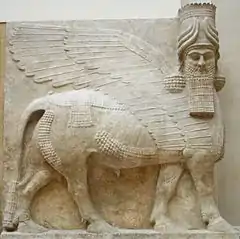List of hybrid creatures in folklore
The following is a list of hybrid entities from the folklore record grouped morphologically based on their constituent species. Hybrids not found in classical mythology but developed in the context of modern pop culture are listed in a separate section. For actual hybridization in zoology, see Hybrid (biology)#In different taxa.
Partly human
Human-horse hybrids (centauroid)

A Centaur fighting a man
- Anggitay – A strictly-female creature that has the upper body of a human with the lower body of a horse.
- Centaur – A creature that has the upper body of a human with the lower body of a horse.
- Onocentaur – A creature that has the upper body of a human with the lower body of a donkey.
- Ipotane – A human with the hindquarters of a horse.
Human-goat hybrids
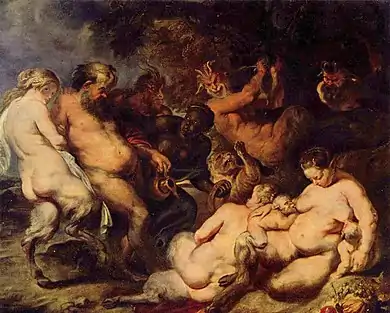
Satyr men, satyr women, and satyr children.
Goat people are a class of mythological beings who physically resemble humans from the waist up, and had goat-like features usually including the hind legs of goats. They fall into various categories, such as sprites, gods, demons, and demigods.[1]
- Faun – An ancient Roman nature spirit with the body of a man, but the legs and horns of a goat.[2][3] Originally they differed from the Greek satyrs because they were less frequently associated with drunkenness and ribaldry and were instead seen as "shy, woodland creatures".[4] Starting in the first century BC, the Romans frequently conflated them with satyrs and, after the second century AD, the two are virtually indistinguishable.[2][3][4]
- Glaistig – A Scottish fairy or ghost who can take the form of a goat-human hybrid.[5][6]
- Krampus — A Germanic mythical figure of obscure origin. It is often depicted with the legs and horns of a goat, the body of a man, and animalistic facial features.
- Pan – The god of the wild and protector of shepherds, who has the body of a man, but the legs and horns of a goat. He is often heard playing a flute.
- Satyr – Originally an ancient Greek nature spirit with the body of a man, but the long tail and pointed ears of a horse.[2][3] From the beginning, satyrs were inextricably associated with drunkenness and ribaldry, known for their love of wine, music, and women.[2][3][7] By the Hellenistic Period, satyrs gradually began to be depicted as men with the horns and legs of goats, likely due to conflation with Pan.[2][3] They were eventually conflated with the Roman fauns and, since roughly the second century AD, they have been indistinguishable from each other.[2][3][4]
Human-bird hybrids
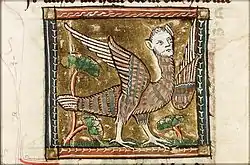
A medieval depiction of a harpy as a bird-woman
- Alkonost – A creature from Russian folklore with the head of a woman with the body of a bird, said to make beautiful sounds that make anyone who hears them forget all that they know and not want anything more ever again.
- Gamayun – A Russian creature portrayed with the head of a woman and the body of a bird.
- Inmyeonjo – A human face with bird body creature in ancient Korean mythology.
- Harpy – A half-bird, half-woman creature of Greek mythology, portrayed sometimes as a woman with bird wings and legs.
- Kinnara – Half-human, half-bird in later Indian mythology.
- Lamia – Woman with duck feet.
- Lilitu – A woman with bird legs (and sometimes wings) found in Mesopotamian mythology.
- Siren – Half-bird, half-woman creature of Greek mythology, who lured sailors to their deaths with their singing voices.
- Sirin – Half-bird, half-human creature with the head and chest of a woman from Russian folklore. Its bird half is generally that of an owl's body.
- Uchek Langmeidong - A half-woman and half-hornbill creature in Manipuri folklore, depicted as a girl who was turned into a bird to escape from her stepmother's torture in the absence of her father.
Human-fish hybrids
- Atargatis – Human face, fish body.
- Ceasg – A Scottish mermaid.
- Ichthyocentaurs – Creatures that have the torsos of a man or woman, the front legs of a horse, and the tails of a fish.
- Jengu – A water spirit
- Matsya – An avatar of Lord Vishnu that is half-man half-fish.
- Merfolk – A race of half-human, half-fish creatures. The males are called Mermen and the females are called Mermaids.
- Sirena – A mermaid from Philippine folklore.
- Siyokoy – Mermen with scaled bodies from Philippine folklore. It is the male counterpart of the Sirena.
- Triton - A Greek God and the son of Poseidon who has the same description as the Merman. Some depictions have him with two fish tails.
Human-snake hybrids
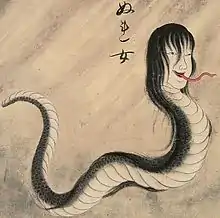
A nure-onna as depicted in Sawaki Suushi's Hyakkai-Zukan
- Draconope (snake-feet) – "Snake-feet are large and powerful serpents, with faces very like those of human maidens and necks ending in serpent bodies" as described by Vincent of Beauvais.[8]
- Echidna – A half-woman and half-snake monster that lives inside a cave.
- Fu Xi – A god said to have been made by Nu Wa.
- Ketu – An Asura who has the lower parts of a snake and said to have four arms.
- Lamia – Like a mermaid but with the lower body like that of a snake and is usually female.
- Nāga – A term referring to human/snake mixes of all kinds.
- Nü Wa – A woman with the lower body of a serpent in Chinese folklore.
- Nure-onna – A creature with the head of a woman and body of a snake.
- Tlanchana – An aquatic deity that is part woman and part snake.
- Zhuyin – A creature with the face of a man and the body of a snake.
Other hybrids
- Adlet – A human with dog legs.
- Bes – An Egyptian god with the hindquarters of a lion.
- Keibu Keioiba - A tiger-headed human in Manipuri folklore.
- Kurma – Upper-half human, lower half tortoise.
- Kusarikku – A demon with the head, arms, and torso of a human and the ears, horns, and hindquarters of a bull.
- Manticore - A creature with the face of a man, the body of a lion, the wings of a bat or a dragon and the tail of a scorpion
- Nandi – Some Puranas describe Nandi or Nandikeshvara as bull-faced, with a human body that resembles that of Shiva in proportion and aspect.
- Penghou – A creature with the face of a man and the body of a dog.
- Scorpion Man – Half-man half-scorpion.
Human-headed, complex body (often with parts from multiple animals)
- Avatea – A Mangaian god that has the right half of a man and the left half of a fish.
- Bai Ze – A creature from Chinese mythology with the head of a human and the body of a cattle with six horns and nine eyes.
- Buraq – A creature from Arabic iconography that has the head of a man and the body of a winged horse.
- Hatuibwari – A dragon-like creature with the head of a human with four eyes, the body of a serpent, and the wings of a bat.
- Kamadhenu – A bovine creature with the head of a human, the body of a cow, the wings of a pigeon, and the tail of a peacock.
- Meduza – A sea creature from Russian folklore with the head of a maiden and the body of a striped beast, having a dragon tail with a snake's mouth and elephant legs with the same snake mouths.
- Lamassu – A deity that is often depicted with a human head, a bull's body or lion's body, and an eagle's wings.
- Sphinx – A creature with the head of a human or a cat, the body of a lion, and occasional wings of an eagle.
Human with animal head
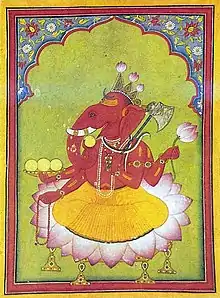
Ganesha, with Elephant's head
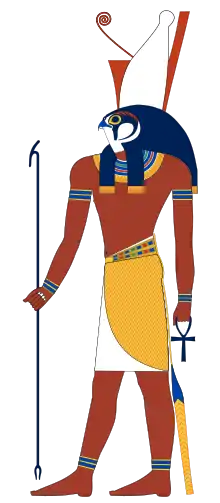
Horus, with Falcon's head
- Abraxas – A god-like Gnostic creature with many different types of portrayals, many of which as different types of hybrids.
- Anubis – The jackal-headed Egyptian God.
- Baphomet – Traditionally depicted as an anthropomorphic creature with goat's head
- Bastet – The cat-headed Egyptian Goddess.
- Bird goddess – Vinca figures of a woman with a bird head
- Capelobo - A creature from Brazilian folklore with the head of an anteater, the torso of a human, and the legs of a goat.
- Cernunnos – An ancient Gaulish/Celtic God with a head of a deer.
- Chi You – A creature from Chinese mythology with the head of a bull, the torso of a human and the ears and hindquarters of a bear.
- Cuca - A creature from Brazilian folklore and female counterpart of the Coco that is depicted as a witch with the head of an alligator. It will catch and eat children that disobey their parents.
- Cynocephalus – A dog-headed creature.
- Daksha – His head was replaced by a goat's head after a beheading.
- Ganesha – An elephant-headed God.
- Hayagriva – A horse-headed avatar.
- Heqet – The frog-headed Egyptian God.
- Horse-Face – A horse-headed guardian or type of guardian of the Underworld in Chinese mythology.
- Horus, Monthu, Ra, and Seker – Each of these Egyptian Gods has the head of a falcon or hawk.
- Karasu-tengu – A crow-type Tengu.
- Karura – A divine creature of Japanese Hindu-Buddhist mythology with the head of a bird and the torso of a human.
- Keibu Keioiba - A tiger headed human, who was a priest voluntarily transformed his body, in Manipuri folklore.
- Khepri – The dung beetle-headed Egyptian God.
- Khnum – The ram-headed Egyptian God.
- Kuk – Kuk's male form has a frog head while his female form has a snake head.
- Maahes, Pakhet, Sekhmet, and Tefnut – Each of these Egyptian Gods has the head of a lion.
- Meretseger – The cobra-headed Egyptian Goddess.
- Minotaur – A creature with the head of a bull and the body of a man. Some depictions have it also sporting the tail and/or hindquarters of a bull.
- Nandi – Some Puranas describe Nandi or Nandikeshvara as bull-faced, with a human body that resembles that of Shiva in proportion and aspect.
- Narasimha – A Hindu deity with a lion-like face.
- Ox-Head – An ox-headed guardian or type of guardian of the Underworld in Chinese mythology.
- Pratyangira – A Hindu Goddess having the head of a lion.
- Sekmet – The lioness-headed Egyptian Goddess.
- Set – The dog-headed Egyptian God.
- Sobek – The crocodile-headed Egyptian God.
- Taweret – The hippopotamus-headed Egyptian Goddess.
- Thoth – The ibis-headed Egyptian God.
- Varaha – A boar-headed avatar.
- Zhu Bajie – A pig-headed major character of the novel Journey to the West.
Human with added animal parts
.JPG.webp)
Horns of a goat and a ram, goat's fur and ears, nose and canines of a pig, a typical depiction of the devil in Christian art. The goat, ram and pig are consistently associated with the Devil.[9] Detail of a 16th-century painting by Jacob de Backer in the National Museum in Warsaw.
- Winged
- Angel – Humanoid creatures who are generally depicted with bird-like wings. In Abrahamic mythology and Zoroastrianism mythology, angels are often depicted as benevolent celestial beings who act as messengers between God and humans.
- Fairy – A humanoid with insect-like wings.
- Mothman – A humanoid moth.
- Seraph – An elite angel with multiple wings.
- Winged genie – A humanoid with bird wings.
- Legs
- Anansi - A West African god, also known as Ananse, Kwaku Ananse, and Anancy. In the Americas he is known as Nancy, Aunt Nancy and Sis' Nancy. Anansi is considered to be the spirit of all knowledge of stories. He is also one of the most important characters of West African and Caribbean folklore. Anansi is depicted in many different ways: sometimes he looks like an ordinary spider, sometimes he is a spider wearing clothes or with a human face, and sometimes he looks much more like a human with spider elements, such as eight legs.
- Drakaina – A female species from Greek mythology that is draconian in nature, primarily depicted as a woman with dragon features.
- Horned
- Hathor – An Egyptian goddess with cow horns.
- Horned God – A god with horns.
- Bat – An Egyptian goddess with the horns and ears of a cow.
- Snake-haired
Part animal, part human (transitioning between the two)
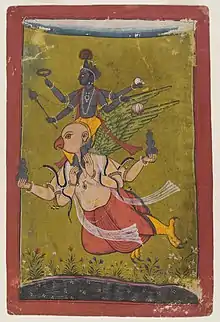
Garuda carrying his master Vishnu. Garuda has an eagle's head, wings and legs
- Garuda – A creature that has the head, wings, and legs of an eagle and body of a man.
- Selkie – A seal that becomes a human by shedding its skin on land.
- Werecat – A creature that is part cat, part human, or switches between the two.
- Werewolf – A creature that becomes a wolf/human-like beast during the nights of full moons, but is human otherwise.
Non-human
Quadrupeds with the wings of a bird
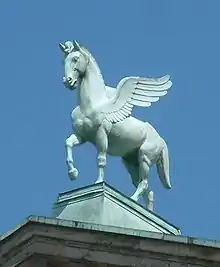
Pegasus, as the horse of Muses, was put on the roof of Poznań Opera House (Max Littmann, 1910)
- Pegasus – A horse with the wings of a bird.
- Peryton – A deer with the wings of a bird.
- Winged Cat – A cat with the wings of a bird.
- Winged Lion – A lion with the wings of a bird.
Two kinds of animal parts

Detail of the embroidered dress of an Apkallu, showing a pair of 4-legged winged animals. From Nimrud, Iraq. 883-859 BCE. Ancient Orient Museum, Istanbul
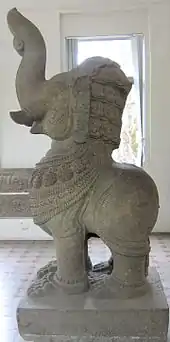
'Gajasimha', Museum of Cham Sculpture
- Allocamelus – A Heraldic creature that has the head of a donkey and the body of a camel.
- Cockatrice – A mix between a chicken and a reptile.
- Cerberus – A Greek mythological dog that guarded the gates of the underworld, almost always portrayed with three heads and occasionally having a mane of serpents, as well as the front half of one for a tail.
- Criosphinx – A Sphinx that has the head of a ram.
- Feathered serpent - A Mesoamerican spirit deity that possessed a snake-like body and feathered wings.
- Gajamina – A creature with the head of an elephant and body of a fish.
- Gajasimha – A creature with the head of an elephant and the body of a lion.
- Griffin – A creature with the front quarters of an eagle and the hind quarters of a lion.
- Gye-lyong – A creature with the head of a chicken and the body of a dragon.
- Hieracosphinx – A type of Sphinx that had a falcon head.
- Hippalectryon – A creature with the front half of a horse and the rear half has a rooster's wings, tail, and legs.
- Hippocampus (or Hippocamp) – A Greek mythological creature that is half-horse half-fish.
- Hippogriff – A creature with the front quarters of an eagle and hind quarters of a horse.
- Longma – A winged horse with dragon scales.
- Merlion – A creature with the head of a lion and the body of a fish.
- Ophiotaurus – A creature that has the lower body of a bull and the upper body of a snake.
- Pamola - A creature from Abenaki mythology with a human body, the head of a moose, and wings and feet of an eagle that protects Maine's tallest mountain.
- Capricorn – A creature that is half-goat half-fish, and identified with the constellation Capricornus.
- Serpopard – A creature that is part-snake and part-African leopard.
- Shug Monkey – A creature that is part-monkey and part-dog.
- Skvader – A Swedish creature with the forequarters and hind-legs of a hare and the back, wings and tail of a female wood grouse.
- Tatzelwurm – A creature with the face of a cat and a serpentine body.
- Ushi-oni – A Yōkai with the head of a bull and the body of a spider.
Three kinds of animal parts
- Ammit – An Egyptian creature with the head of a crocodile, the front legs of a lion, and the back legs and hindquarters of a hippopotamus.
- Chalkydri – Creatures with twelve angel wings, the body of a lion, and the head of a crocodile mentioned in 2 Enoch[10]
- Chimera – A Greek mythology creature with the head and front legs of a lion, the head and back legs of a goat, and the head of a snake for a tail. Said to be able to breathe fire from lion's mouth.
- Jackalope – A jackrabbit with the horns of a pronghorn and sometimes the tail and/or legs of a pheasant.
- Sharabha – A Hindu mythological creature having the head of a lion, the legs of deer, and the wings of bird.
- Simurgh – A griffin-like creature of Persian mythology with the head of a dog, the body of a lion and the wings of a hawk.
- Wyvern – A creature with a dragon's head and wings, a reptilian body, two legs, and a tail often ending in a diamond- or arrow-shaped tip.
Four kinds of animal parts
- Enfield – A Heraldic creature with the head of a fox, the forelegs and sometimes wings of an eagle, the body of a lion, and the tail of a wolf.
- Hatsadiling – A mythical creature with the head and body of a lion, trunk and tusks of an elephant, the comb of a rooster, and the wings of a bird.[11]
- Monoceros – A creature with the head of a deer, the body of a horse, the feet of an elephant, and the tail of a pig.
- Nue – A Japanese Chimera with a monkey head, tiger legs, dog body, and the front half of a snake for a tail.
- Questing Beast – A creature with the head and tail of a serpent, the feet of a deer, the body of a lion, and the haunches of a leopard.
- Tarasque – A French dragon with the head of a lion, six short legs similar to that of bear legs, the body of an ox, the shell of a turtle, and a scorpion stinger-tipped tail.
- Wolpertinger – A creature with the head of a rabbit, the antlers of a deer, and the legs and wings of a bird.
- Yali – A Hindu creature with the head of a lion, the tusks of an elephant, the body of a cat, and the tail of a serpent.
- Ypotryll – A Heraldic creature with the tusked head of a boar, the humped body of a camel, the legs and hooves of an ox or goat, and the tail of a snake.
Five or more kinds of animal parts
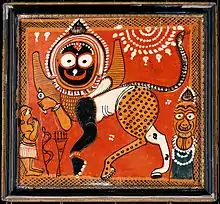
Navagunjara, has limb representing eight animals, including a human hand.
- Alebrije – A brightly colored creature from Mexican mythology.
- Baku – A Japanese creature with the head of an elephant, the ears of a rhinoceros, the legs of a tiger, the body of a bear and the tail of a cow.
- Calygreyhound – A mythical creature described as having the head of a wildcat, the torso of a deer or antelope, the claws of an eagle as its forefeet, ox hooves, antlers or horns on its head, the hind legs of a lion or ox and its tail like a lion or poodle.
- Fenghuang – A Chinese creature with the head of a golden pheasant, the body of a mandarin duck, the tail of a peacock, the legs of a crane, the mouth of a parrot and the wings of a swallow.
- Kotobuki - A Japanese Chimera with the head of a rat, the ears of a rabbit, the horns of an ox, the comb of a rooster, the beard of a sheep, the neck of a Japanese dragon, the mane of a horse, the back of a wild boar, the shoulders and belly of a South China tiger, the arms of a monkey, the hindquarters of a dog, and the tail of a snake.
- Navagunjara – A Hindu creature with the head of a rooster, neck of a peacock, back of a bull, tail as a serpent, three legs of an elephant, tiger and deer or horse, fourth limb being a human hand holding a lotus.
- Pulgasari/Bulgasari - see Pulgasari for modern rendering
- Pyinsarupa – A Burmese creature made of a bullock, carp, elephant, horse and the dragon.
- Qilin – A Chinese creature with the head of a dragon, the antlers of a deer, the scales of a fish, the hooves of an ox, and the tail of a lion. The Japanese version is described as a deer-shaped dragon with the tail of an ox.
- Wolpertinger - Descriptions vary.
Modern fiction
The following hybrid creatures appear in modern fiction:
- Beast (Beauty and the Beast): The Beast, from the Disney movie Beauty and the Beast, has the head structure and horns of a buffalo, the arms and body of a bear, the eyebrows of a gorilla, the jaws, teeth, and mane of a lion, the tusks of a boar, and the legs and tail of a wolf.
- Cecaelia – Half-human, half-octopus. Ursula, from Disney's The Little Mermaid, is a cecaelia.
- Cheetaur – Half-man, half-cheetah. They are featured in the Quest for Glory video games.
- Cervitaur – A deer-type centaur. This description was also used for the Golden Hind from Hercules: The Legendary Journeys.
- Dracotaur – Half-man, half-dragon. It debuted in Dungeons & Dragons. It also has a counterpart in the form of the Dragonspawn from the Warcraft franchise. Dragoon from the Monster Rancher franchise also fits this description due to it being a fusion of a Dragon and a Centaur.
- Drider – Half-Drow half-spider. It debuted in Dungeons & Dragons.
- Gnoll – Vicious hybrid with human-like body and hyena-like head. It debuted in Dungeons & Dragons and was also featured in World of Warcraft. Inspired from but not resembling the gnoles conceived by Lord Dunsany.[12] Considered one of the "five main "humanoid" races" in AD&D by Paul Karczag and Lawrence Schick.[13]
- Gorilla bear – A creature with the head, body, and legs of a gorilla, and the teeth and arms of a bear. It debuted in Dungeons & Dragons.
- Gwazi – A creature with the head of a tiger and the body of a lion. This is the mascot of the defunct roller coaster located at the Busch Gardens amusement park in Tampa, Florida.
- Jackalote - A hybrid of a jackal and a coyote. They appear in The Christmas Chronicles 2 where Belsnickel created them through an unknown method so that they would pull his sleigh.
- Jaquin – A creature that resembles a jaguar with the wings and feathers of macaws. It is featured in Elena of Avalor.
- Kalidahs - Half tiger, half bear creatures first appearing in the book The Wonderful Wizard of Oz by L. Frank Baum.
- ManBearPig – half man, half bear, half pig. Debuted in the animated television series, South Park.
- Miga - A mythical sea creature that is half-killer whale, half-Kermode bear who is one of the mascots of the 2010 Winter Olympics.
- Owlbear – A creature that is half-bear half-owl. It debuted in Dungeons & Dragons.
- Posleen – A crocodile-headed reptilian centaur from Legacy of the Aldenata.
- Sumi – An animal guardian spirit with the wings of a Thunderbird and the legs of an American black bear who is one of the mascot of the 2010 Winter Paralympics.
- Unitaur – A unicorn-type centaur.
- Ursagryph – A creature with the head, claws, and wings of an eagle and the body of a bear. The Predacon Darksteel from Transformers Prime Beast Hunters: Predacons Rising transforms into a mechanical Ursagryph.
- Vampire-werewolf hybrid – These half-vampire half-werewolf hybrids had been shown in various media appearances like AdventureQuest (as a Werepyre), AdventureQuest Worlds (also as a Werepyre), Axe Cop (as a Wolvye), Supernatural, The Elder Scrolls, The Vampire Diaries, the Underworld franchise (as a Lycan-dominant vampire hybrids and a Lycan-Corvinus strain hybrid), and Werewolf: The Apocalypse.
- Vinicius – Part-cat, part-monkey, part-bird from Rio 2016.
- Wemic – Half-man, half-lion. It debuted in Dungeons & Dragons. It also has a counterpart in the form of the Liontaur from the Quest for Glory video games.
- Wolftaur – Half-man, half-wolf. It debuted in Dungeons & Dragons. Some depictions of this creature also have wolf heads like Celious from the Monster Rancher franchise (who is depicted as a fusion of a Tiger and a Centaur) and AdventureQuest 3D (as a Lychimera).
References
- Nathan Robert Brown (30 September 2014). The Mythology of Grimm: The Fairy Tale and Folklore Roots of the Popular TV Show. Penguin Publishing Group. pp. 195–. ISBN 978-0-698-13788-2.
- Riggs, Don (2014). "Faun and Satyr". In Weinstock, Jeffrey Andrew (ed.). The Ashgate Encyclopedia of Literary and Cinematic Monsters. New York City, New York and London, England: Ashgate Publishing. pp. 233–236. ISBN 978-1-4094-2563-2.
- Hansen, William F. (2004). Classical Mythology: A Guide to the Mythical World of the Greeks and Romans. Oxford, England: Oxford University Press. pp. 279–280. ISBN 978-0-19-530035-2.
- Miles, Geoffrey (2009) [1999]. Classical Mythology in English Literature: A Critical Anthology. New York City, New York and London, England: Routledge. p. 30. ISBN 978-0-203-19483-6.
- Rev. J. G. Campbell, "Superstitions of the islands and Highlands of Scotland", Scottish Celtic Review 4 (1885), pp155, 157, noted in J. G. McKay, "The Deer-Cult and the Deer-Goddess Cult of the Ancient Caledonians" Folklore 43.2 (June 1932), pp. 144–174). p. 152.
- Sue Weaver (16 April 2011). The Backyard Goat: An Introductory Guide to Keeping and Enjoying Pet Goats, from Feeding and Housing to Making Your Own Cheese. Storey Publishing, LLC. pp. 142–. ISBN 978-1-60342-699-2.
- West, Martin Litchfield (2007). Indo-European Poetry and Myth. Oxford, England: Oxford University Press. p. 293. ISBN 978-0-19-928075-9.
- Franklin-Brown, Mary (2012). Reading the world : encyclopedic writing in the scholastic age. Chicago London: The University of Chicago Press. p. 258. ISBN 9780226260709.
- Fritscher, Jack (2004). Popular Witchcraft: Straight from the Witch's Mouth. Popular Press. p. 23. ISBN 0-299-20304-2.
The pig, goat, ram — all of these creatures are consistently associated with the Devil.
- Platt, Rutherford (1926). The Lost Books of the Bible and the Forgotten Books of Eden. Entry: The Book of the Secrets of Enoch chapter XII
- Stratton, Carol (2004). Buddhist Sculpture of Northern Thailand. Serindia Publications, Inc. ISBN 9781932476095.
- Forest, Richard W. (2014). "Dungeons & Dragons, Monsters in". In Weinstock, Jeffrey (ed.). The Ashgate Encyclopedia of Literary and Cinematic Monsters. Ashgate Publishing.
- Schick, Lawrence (1991). Heroic Worlds: A History and Guide to Role-Playing Games. Prometheus Books. p. 92. ISBN 0-87975-653-5.
This article is issued from Wikipedia. The text is licensed under Creative Commons - Attribution - Sharealike. Additional terms may apply for the media files.
